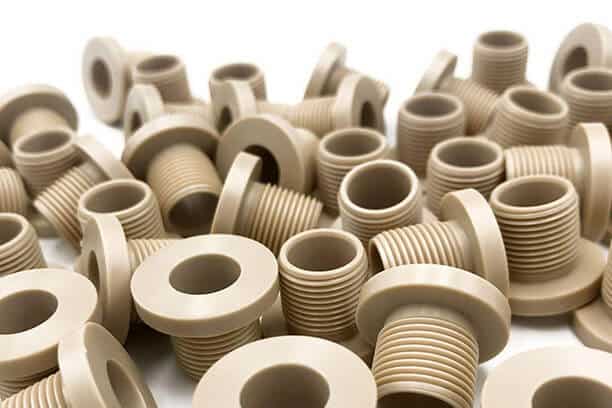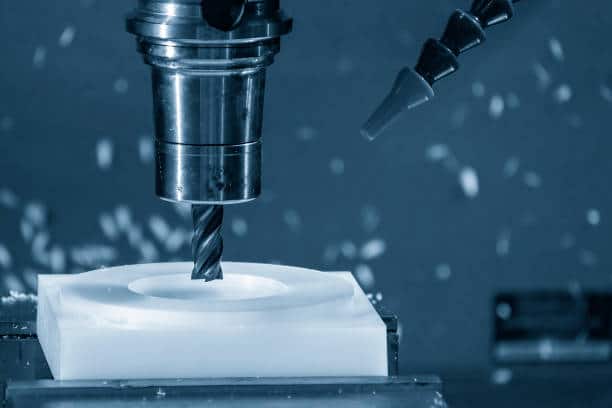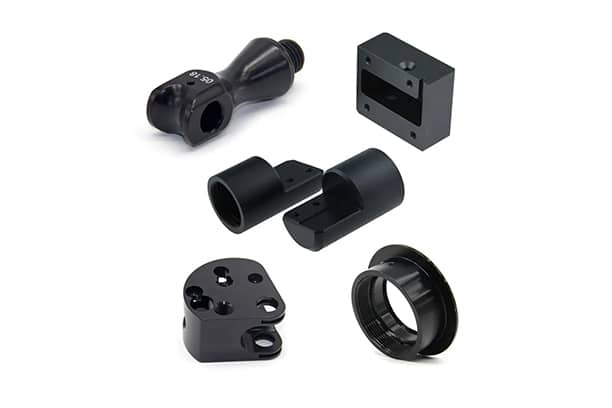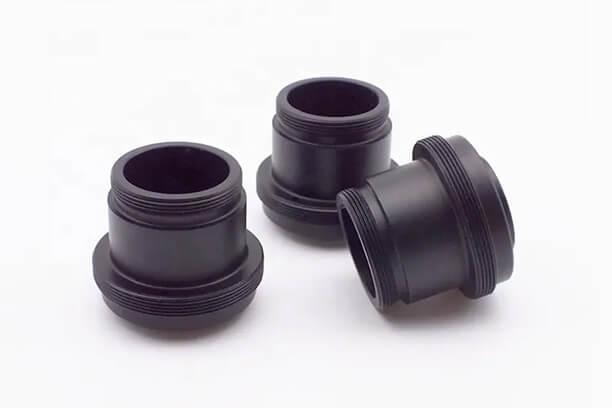Polyetheretherketone (PEEK) is a high-performance thermoplastic used in the production of parts subjected to harsh environments such as high temperatures and chemicals. Being lightweight, it provides an excellent alternative to the majority of soft metals. However, its machining process is complicated, and it requires a level of expertise and experience to work successfully.
In this article, we’ll talk about PEEK CNC machining, how it works, its pros and cons, tips for the CNC machining PEEK process, surface finishes and applications for PEEK parts. Lets’s move forward to learn more.
Overview of PEEK
Polyetheretherketone, or PEEK for short, is an exceptional thermoplastic that boasts high-performance capabilities in engineering. It’s an ideal lightweight substitute for soft metals that require withstanding high stress and high temperature.
PEEK has significant durability and it’s known for its resistance to wear and abrasion. Additionally, it is similar to PPS in that it can withstand chemicals and water. It is also capable of bearing high temperatures, with a melting point of 343°C, and can retain its physical characteristics when continuously exposed to temperatures as high as 250°C without suffering any permanent damage.
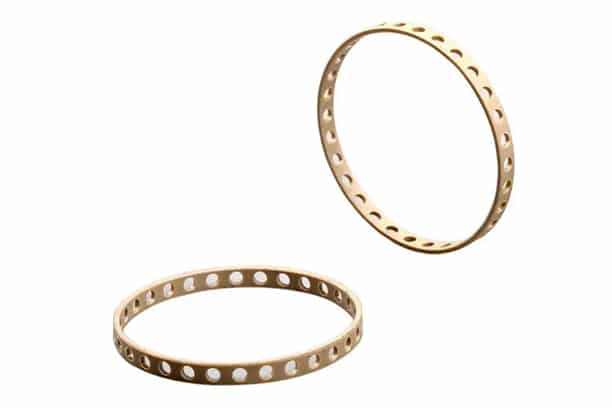
PEEK is a versatile material that can be acquired in various forms, including sheets, bars, tubes, pellets, and filaments. Apart from unfilled PEEK, the material can be reinforced with either 30% glass fiber or 30% carbon fiber, resulting in a reinforced product. Glass-filled PEEK has notable properties, including high durability, rigidity, and strength, and is capable of maintaining dimensional stability in harsh thermal and chemical situations due to the inclusion of glass fibers.
PEEK is commonly divided into two categories, industrial grade, and medical grade. Industrial-grade PEEK is utilized in diverse industries such as aerospace, automotive, chemical, electronics, and energy, while medical-grade PEEK is used in the healthcare and dental sector.
Properties of PEEK
| PEEK | 30% Glass Filled | |
| Yield Strength (tensile) | 14,000 psi | 14,000 psi |
| Elongation at Break | 20% | 3% |
| Hardness | Rockwell R125 | Rockwell R126 |
| Density | 0.047 lbs / cu. in. | 0.054 lbs / cu. in. |
| Maximum Temp | 480° F | 480° F |
How Does CNC Machining PEEK Work
PEEK machining involves a subtractive manufacturing process where it removes extra material from a block of PEEK plastic by performing milling, turning, or cutting operations. The CNC machine reads a CAD model file and converts it into a G code program, which is then utilized to quickly create components from the raw material blocks.
The PEEK machining process is precisely regulated by a specialized computer system, which enhances the reliability and consistency of the process by reducing the potential for human error. The dimensional and feature requirements of PEEK parts determine the selection of a multi-axis machine, while a single setup with intricate geometry is necessary to guarantee the accuracy of components.
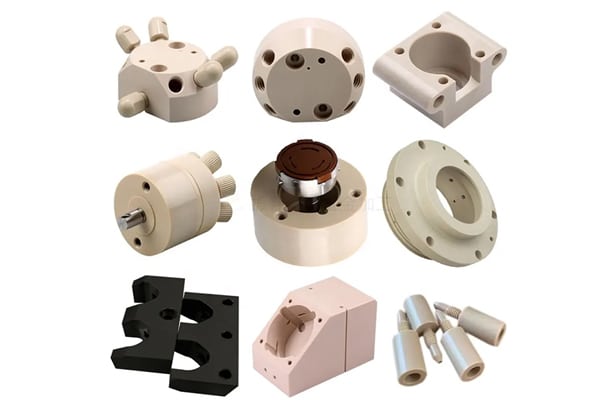
Pros and Cons of Machining PEEK
PEEK is an alternative option to metals for creating parts, but like any other material used in manufacturing, it comes with its own advantages and disadvantages. Here, we’ll discuss the two aspects:
Advantages
PEEK machining offers numerous benefits, which can be categorized into two groups: the inherent advantages of PEEK material and the specific process benefits of using a CNC machine to fabricate PEEK material.
1. Corrosion resistance
PEEK is highly resistant to corrosive substances and exhibits a level of resistance similar to nickel steel, retaining its non-corrosive chemical structure even at high temperatures. Typically, only powerful sulfuric acid has the ability to dissolve this plastic under normal circumstances.
2. Low moisture absorption
Devices or machinery components constructed from PEEK maintain their chemical constitution and qualities in damp environments, making it an ideal material for use in steam, moist settings, or pressured hot water. Furthermore, PEEK’s hydrolysis resistance capabilities, even at higher temperatures, enhance its suitability for use in these environments.
3. Irradiation resistance
PEEK components are also capable of operating effectively when subjected to intense ionizing radiation. It is more resistant to gamma radiation than polystyrene.
4. Resistance to high temperature
PEEK plastic shows outstanding machinability in plastic CNC precision milling, thanks to its exceptional processing capabilities. Despite being a high-temperature thermoplastic, it is compatible with a variety of material processing techniques.
PEEK’s impressive thermal breakdown characteristics and workability at high temperatures ensure its suitability for such applications. Moreover, PEEK is self-extinguishing when exposed to flames, and it emits minimal hazardous gas or smoke.
5. Mechanical characteristics
PEEK demonstrates remarkable impact resistance and can maintain its shape at elevated temperatures. With high dimensional stability and a low coefficient of linear expansion, PEEK possesses the greatest ability among polymers to resist stress and fatigue. Moreover, its excellent creep resistance, and the capacity to resist deformation over an extended period of exposure to stress, make it an optimal material for handling high machining stress.
Moreover, PEEK has exceptional wear resistance capabilities and a low friction coefficient, which allows it to continue exhibiting high resistance to wear across various physical circumstances such as temperature, pressure, speed, and surface roughness regarding the point of contact.
Disadvantages
Though PEEK machining has numerous advantages, it also comes with several drawbacks. Here are some of them:
- To minimize internal tension and fractures caused by heat, special precautions are necessary.
- Annealing may be required for PEEK machining.
- Ineffective heat transfer is another downside of PEEK machining.
- Over-drilling may lead to cracking.
Considerations for PEEK CNC Machining
1. Heat and stress
To prevent the occurrence of surface cracks and internal stress attributed to the heat generated during cutting, PEEK rods are required to undergo an annealing procedure before machining. This process serves to release tension and reduce the likelihood of distortion. Multiple annealing procedures may be required depending on how long the machining process will take, such as an initial annealing before roughing and a subsequent one before finishing to avoid cracking.
2. Tool wear
The process of machining industrial-grade PEEK polymers is comparable to that of most medical-grade variants. Nevertheless, medical grade PEEK often incorporates more rigid carbon fibers, necessitating the softening of PEEK material ahead of machining to limit tool wear.
3. Cutting tools
When dealing with natural PEEK, cutting tools composed of silicon carbide can usually be recommended. However, if carbon fiber reinforcement is present or extremely close tolerances are required, diamond tools are the optimal choice. Moreover, utilizing pure water as a coolant during machining is essential to eradicate the cutting heat that is produced.
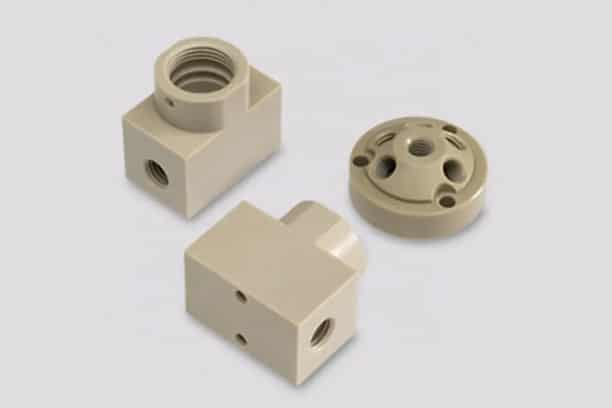
4. Drilling
PEEK has a lower elongation compared to other polymers, which might lead to cracks when drilling deep holes.
5. Contamination
To pollution during the process, the workpiece, CNC machine, clamping fixtures, and tools of the workpiece must be separated from other materials and not mixed with them. For added protection, operators must wear gloves during the machining process.
6. Coolant
Since PEEK doesn’t dissipate heat and is vulnerable to deformation or breakage during machining, it requires cooling. Standard liquid coolant may be employed when machining PEEK parts for medical purposes. However, in this case, pressured air cooling of the material is necessary, as liquid coolant may threaten PEEK’s biocompatibility.
7. Machining parameters
Achieving trouble-free production of PEEK components necessitates observing appropriate drilling, milling, and turning machining parameters.
Other Processes Available for PEEK Machining
PEEK materials are also compatible with 3D printing and injection molding, not limited to CNC machining. The selection of an appropriate manufacturing process is dependent upon the desired end product, budget, and time.
3D printed PEEK parts are increasingly prevalent in the medical field because they can be made with intricate geometries. Primarily, FFF filament and SLS powder are used for medical implants. In contrast, injection molded PEEK parts are extensively employed in the medical and aerospace industries. Nevertheless, since PEEK possesses a high melting point that exceeds the upper limit of many injection molding machines, it is considered a special material for injection molding. For alternative high-temperature materials in this context, PEKK or Ultem may be opted for.
| Characteristics | CNC Machining | Injection molding | 3D printing |
| Repeatability & precision | Excellent | Good | Excellent |
| Complex geometries | Good | Excellent | Good |
| Mechanical performance | Excellent | Good | Excellent |
Surface Finishes for PEEK Parts
PEEK parts ordinarily possess an opaque gray color. Due to the structural nature of PEEK, creating bonds with paints and coatings is a challenge. Nevertheless, because of PEEK’s innate chemical resistance, it is usually feasible to maintain parts in their machined state.
- As Machined: By employing a CNC machining process, PEEK parts may attain a remarkably smooth surface finish of 125 uin Ra.
- Bead Blasting: PEEK parts’ surface can be smoothed via a glass bead machine, eliminating any marks and blemishes.
- Others: In addition to bead blasting, various other services are available, including polishing, edge finishing, laminating, and decal application.
Applications of PEEK Machining
CNC machining is a highly effective way to manufacture products made from PEEK. This material has a variety of uses across different industries, such as automotive, electrical and electronic, aerospace, medical, and food processing, etc.
Industrial-grade PEEK plastic is a common material used in the aerospace, automotive, chemical, electronics, and energy industries, while medical-grade PEEK plastic is more suitable for healthcare and dentistry applications.
Medical Instruments
PEEK can withstand autoclaving cycles and is therefore suitable for making dental descaling tools and endoscope components in the medical industry. In addition, its excellent strength and resistance to dissolution make it a popular material for use in liquid chromatography columns, accessories, and tubes. Moreover, PEEK’s biocompatibility with human tissue has made it a successful replacement for titanium in the production of artificial bones.
Office Machinery Parts
PEEK resin is commonly used to manufacture heat-resistant components such as bearings, chains, and gears for separation claws. This alternative to metal provides lightweight, oil-free, and fatigue-resistant solutions.
Automotive
PEEK resin is rapidly gaining popularity in several industries, especially in the automotive sector. Engine parts, transmission parts, and steering parts are among the components that now utilize PEEK plastic instead of expensive metals for manufacturing. The demand for PEEK resin is expected to rise as the automotive industry looks to reduce costs and achieve miniaturization and lightweight designs. As an example, a European model currently incorporates 44 parts made from PEEK plastic, replacing traditional metal products.
FAQS of PEEK CNC Machining
Custom CNC Machined PEEK Parts – Rely On Runsom Precision
At Runsom Precision, we provide 3-axis and 5-axis CNC PEEK plastic machining services, including milling and turning. Whether you need prototype components or large-volume runs, our services are designed to deliver high-quality PEEK parts efficiently and at an affordable cost. Our manufacturing specialists are available to answer any inquiries regarding your PEEK project, and we provide free advice on design and material machining based on our experience. So, feel free to contact us for all of your PEEK machining needs or request an instant quote online for free right now!
Other Articles You May Be Interested in:

